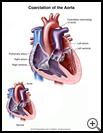
Coarctation of the Aorta
What is coarctation of the aorta?
Coarctation of the aorta (COA) is a problem some children are born with. The big artery that goes from the heart to the body (the aorta) is too narrow. This makes it hard for the blood to flow from the heart to the lower part of the body. The blood backs up above the narrow area, causing high blood pressure (hypertension) in the right arm and in the blood vessels going to the head.
In severe cases, no blood can get through the narrow area. Severe coarctation of the aorta in a newborn infant is a medical emergency that can result in death if it is not treated.
How does it occur?
The cause of this birth defect is not known. Sometimes it happens with other heart defects.
What are the symptoms?
If the narrowing is severe at birth, the baby will soon have symptoms that may include:
- poor feeding
- pale color
- fast breathing.
The lack of blood flow to the lower part of the body may cause the baby to stop making urine.
Babies with minor narrowing often will not develop symptoms until later in life. Most children with coarctation of the aorta, however, will have high blood pressure in their arms and in the blood vessels going to their head. They will have a low blood pressure in their legs. Often the pulse in the legs cannot be felt. Symptoms may include:
- chest pain with exercise
- cold arms or legs
- pain in the legs with exercise
- shortness of breath
- swelling in the arms or legs
- headache
- nosebleeds.
How is it diagnosed?
The baby may have an echocardiogram, which is an ultrasound exam that uses sound waves to make pictures of the aorta and the blood vessels near it.
Cardiac catheterization may also be done. In this procedure, a small tube is placed in the artery of the leg and passed through the artery to the aorta. A special dye is inserted, and X-ray pictures are taken of the aorta and surrounding blood vessels.
How is it treated?
Even when there are no symptoms, surgery is needed to prevent high blood pressure from getting worse over time. The surgery may be done in one of several ways:
- The narrow part of the aorta may be removed and the 2 ends reconnected.
- The narrow part of the aorta may be removed. Then a piece of man-made material may be used to enlarge the aorta where there is a blockage.
- A tiny balloon may be inserted into the aorta to stretch it.
How long will the effects last?
Most children who have successful treatment have no more symptoms and can lead normal lives. Some children will still have high blood pressure that needs to be treated.
No matter which method is used for treatment, regular follow-ups with your healthcare provider and usually a heart specialist are needed. Sometimes the blockage comes back when a child is older. There is also a risk of infection in the repaired area of the aorta. Someone who has had surgery for this problem may need to take antibiotics before any dental work and some medical or surgical procedures. Ask your healthcare provider about this.
Last modified: 2009-08-23
Last reviewed: 2011-05-19

